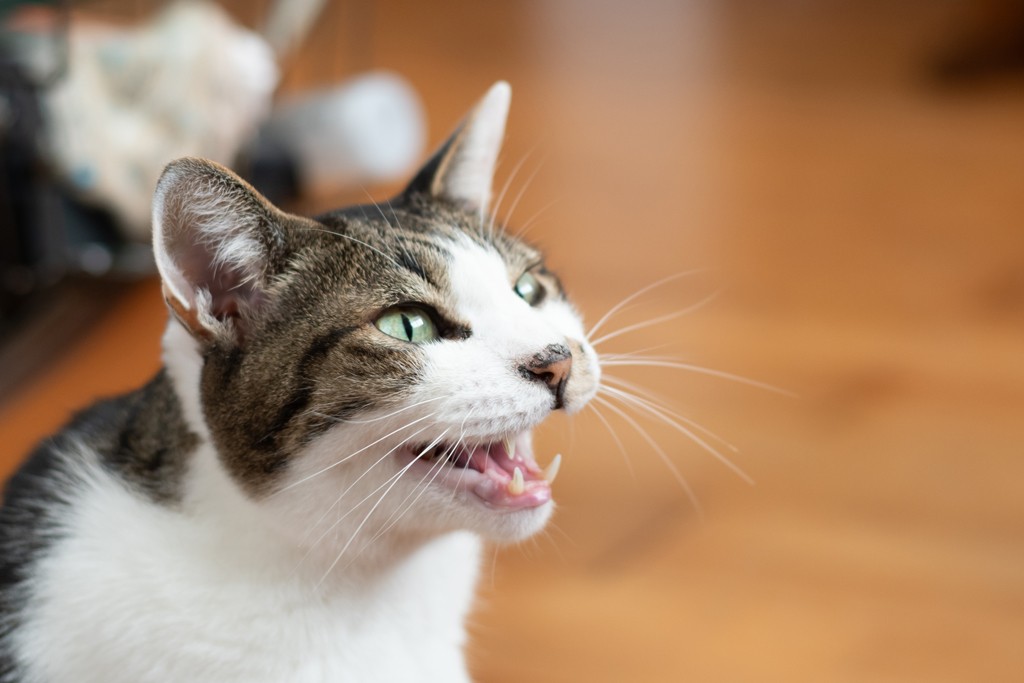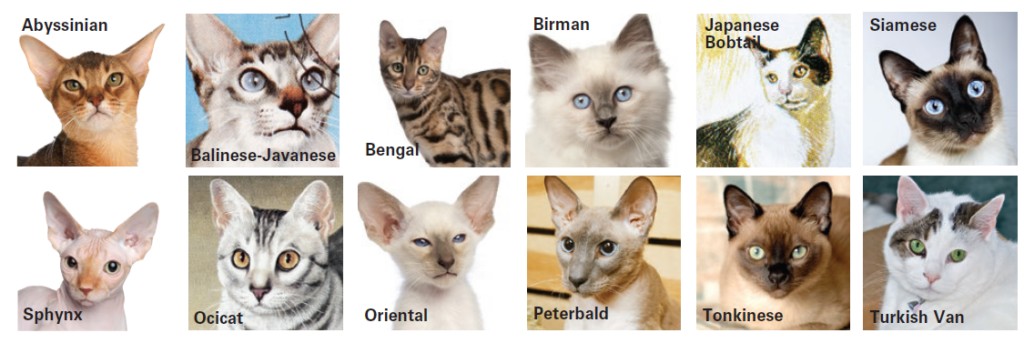Is your cat suddenly serenading you with a symphony of strange sounds? “Why Is My Cat Making Weird Noises?” is a question that plagues many cat owners. At WHY.EDU.VN, we delve into the fascinating world of feline vocalizations to help you decode your cat’s mysterious language. From chirps and trills to yowls and caterwauls, understanding these unique sounds and vocal behaviors can strengthen your bond with your furry friend and provide insights into their emotional and physical well-being. Explore different meow variations, purring nuances, and unusual vocalizations.
1. The Symphony of Sounds: Decoding Your Cat’s Vocalizations
Cats are masters of communication, using a complex repertoire of sounds to express their needs, desires, and emotions. Understanding these vocalizations is key to unlocking a deeper connection with your feline companion. Learning your cat’s specific sounds and their meanings requires dedicated observation.
1.1. Beyond the Meow: A World of Feline Sounds
While the meow is perhaps the most well-known cat sound, it’s just the tip of the iceberg. Cats possess a wide range of vocalizations, each with its own unique meaning. These sounds, combined with body language, provide valuable insights into your cat’s state of mind.
- Purrs: Often associated with contentment, but can also indicate stress or pain.
- Chirps: Bird-like sounds indicating excitement or attention-seeking.
- Hisses: A clear warning sign of fear or aggression.
- Yowls: A drawn-out moan expressing worry, discomfort, or territoriality.
- Growls: A low, guttural sound indicating anger or defensiveness.
1.2. The Science of Feline Vocalizations: A Comprehensive Overview
According to Dr. Nicholas Dodman, a renowned veterinary behaviorist, cats have a sophisticated vocal range that allows them to communicate a wide variety of emotions and needs. The domestic cat has a unique range of vocalizations compared to other animals, and it developed as a means of communicating with humans.
Understanding your cat’s unique vocalizations can improve your relationship with them. This table summarizes common cat vocalizations and their potential meanings:
| Vocalization | Description | Possible Meanings |
|---|---|---|
| Meow | A versatile sound, varying in pitch and duration. | Attention-seeking, greeting, hunger, illness, or stress. |
| Purr | A soft, rumbling sound. | Contentment, pleasure, but sometimes pain or anxiety. |
| Hiss | A sharp, forceful expulsion of air. | Fear, aggression, defensiveness. |
| Growl | A low, guttural rumble. | Anger, territoriality, warning. |
| Yowl | A long, drawn-out moan. | Discomfort, worry, territoriality, mating behavior. |
| Chatter | Rapid, repetitive clicking sounds, often accompanied by teeth chattering. | Excitement, frustration, predatory instinct. |
| Chirp | A bird-like sound. | Excitement, attention-seeking, greeting. |
| Trill | A soft, rolling sound. | Affection, contentment, greeting. |
| Caterwaul | A loud, wailing sound, typically made by unspayed female cats in heat. | Seeking a mate. |
| Scream | A sudden, piercing cry. | Pain, fear, aggression. |



1.3. The Nuances of Meowing: Understanding Pitch, Volume, and Frequency
The meow is not a one-size-fits-all vocalization. Cats vary the pitch, volume, and frequency of their meows to convey different messages. A short, high-pitched meow might be a simple greeting, while a long, drawn-out meow could indicate hunger or distress.
- High-pitched meows: Often indicate urgency, excitement, or pain.
- Low-pitched meows: Can signify dissatisfaction, annoyance, or a demand.
- Frequent meowing: May indicate loneliness, boredom, or an underlying medical condition.
2. Deciphering the Cat Code: Common Cat Sounds and Their Meanings
Let’s take a closer look at some of the most common cat sounds and what they might mean.
2.1. The Classic Meow: Decoding the Different Types of Meows
As mentioned earlier, the meow is a versatile vocalization with a range of meanings. Pay attention to the context in which your cat is meowing to understand the message they’re trying to convey.
- Short, high-pitched meow: A simple greeting or request for attention.
- Long, drawn-out meow: Can indicate hunger, thirst, or a need for something.
- Loud, insistent meow: May signal distress, pain, or a desire to be let in or out.
- Soft, questioning meow: Often used to get your attention in a gentle way.
- Rapid-fire meows: Can indicate excitement, anticipation, or a demand for immediate attention.
2.2. The Soothing Purr: More Than Just Contentment
The purr is often associated with happiness and relaxation, but it can also indicate other emotions. Cats may purr when they are feeling stressed, anxious, or even in pain. The act of purring is believed to release endorphins, which have a calming and pain-relieving effect.
- Contentment purr: A soft, steady rumble, often accompanied by relaxed body language.
- Self-soothing purr: A louder, more intense purr, often occurring when the cat is feeling anxious or stressed.
- Healing purr: Some researchers believe that the vibrations produced by purring can promote healing in cats.
2.3. The Threatening Hiss: A Clear Warning Signal
The hiss is a clear indication that your cat is feeling threatened or afraid. It’s a warning signal that should be respected. Back away and give your cat space to calm down.
- Reasons for hissing: Fear, aggression, pain, or feeling cornered.
- Body language accompanying hissing: Arched back, flattened ears, dilated pupils, and raised fur.
- What to do when your cat hisses: Stay calm, back away slowly, and avoid direct eye contact.
2.4. The Worrisome Yowl: A Cry for Help
The yowl is a long, drawn-out moan that can indicate a variety of issues, from discomfort to territoriality. Pay attention to the context and your cat’s body language to determine the cause of the yowl.
- Reasons for yowling: Pain, discomfort, cognitive dysfunction, territoriality, or seeking a mate.
- When to seek veterinary attention: If your cat is yowling frequently or excessively, it’s important to consult with a veterinarian to rule out any underlying medical conditions.
- Addressing territorial yowling: Ensure your cat has plenty of vertical space, such as cat trees or shelves, to feel secure in their environment.
2.5. The Playful Chirp: Expressing Excitement and Anticipation
The chirp is a bird-like sound that cats often make when they are excited or anticipating something, such as a meal or playtime.
- Reasons for chirping: Excitement, anticipation, or predatory instinct.
- Context of chirping: Often occurs when the cat is watching birds or other prey through a window.
- Encouraging playful chirping: Provide your cat with plenty of opportunities for play and enrichment.
2.6. The Frustrated Chatter: Predatory Instincts Unleashed
The chatter is a rapid, repetitive clicking sound that cats often make when they are watching prey that they can’t reach, such as birds or squirrels outside a window.
- Reasons for chattering: Frustration, excitement, predatory instinct.
- Accompanying behaviors: Tail twitching, crouching, and focused gaze.
- Redirecting predatory behavior: Provide your cat with interactive toys that allow them to satisfy their hunting instincts in a safe and controlled environment.
2.7. The Mating Call: Understanding the Caterwaul and Scream
The caterwaul is a loud, wailing sound that female cats make when they are in heat, signaling their availability to potential mates. The scream is a piercing cry that can occur during mating.
- Importance of spaying and neutering: Spaying or neutering your cat can prevent these vocalizations and help control the pet population.
- Addressing caterwauling: If your cat is caterwauling, keep them indoors to prevent unwanted pregnancies.
2.8 Unraveling the Mystery of Cat Talk: Exploring Other Sounds
Beyond the standard meows and purrs, cats possess a rich array of unique sounds.
Understanding cat vocalizations goes beyond the meow. This table explores other unique sounds your cat might make:
| Vocalization | Description | Possible Meanings |
|---|---|---|
| Growl | A low, rumbling sound, often accompanied by bared teeth and flattened ears. | Usually indicates aggression or defensiveness. Your cat may be feeling threatened and warning others to stay away. |
| Hiss | A sharp, forceful expulsion of air, often accompanied by an arched back and puffed-up fur. | A clear warning sign of fear, anger, or pain. Your cat is telling you to back off. |
| Yowl | A long, drawn-out, mournful cry. | Can signify a variety of issues, including pain, discomfort, cognitive dysfunction, or territoriality. |
| Caterwaul | A loud, wailing cry, typically made by unspayed female cats in heat. | A mating call to attract male cats. |
| Chatter | A rapid, repetitive clicking sound, often accompanied by teeth chattering. | Often indicates excitement or frustration, particularly when your cat is watching prey they can’t reach. |
| Chirp | A bird-like sound, often described as a “murr” or “prrr”. | Often expresses excitement or attention-seeking behavior. Your cat might be trying to get your attention or indicating that they’ve spotted something interesting. |
| Trill | A soft, rolling sound, similar to a purr but higher in pitch. | Often signifies a friendly greeting or a desire for attention. |
| Scream | A sudden, piercing cry. | Can indicate pain, fear, or a sudden surprise. |
3. Medical Reasons for Unusual Cat Noises
Sometimes, unusual cat noises can be a sign of an underlying medical condition. It’s important to be aware of the potential medical causes of these sounds and to consult with a veterinarian if you are concerned.
3.1. Respiratory Issues: Asthma, Infections, and More
Respiratory problems can cause a variety of unusual noises, such as wheezing, coughing, and labored breathing.
- Asthma: A chronic respiratory disease that can cause inflammation and narrowing of the airways.
- Upper respiratory infections: Common in cats, especially kittens, and can cause sneezing, coughing, and nasal discharge.
- Pneumonia: An infection of the lungs that can cause difficulty breathing and coughing.
3.2. Cognitive Dysfunction: Senility and Confusion
As cats age, they can develop cognitive dysfunction, which is similar to Alzheimer’s disease in humans. This can lead to confusion, disorientation, and unusual vocalizations, such as excessive meowing or yowling.
- Symptoms of cognitive dysfunction: Disorientation, changes in sleep patterns, loss of interest in activities, and increased vocalization.
- Managing cognitive dysfunction: There are medications and environmental modifications that can help manage the symptoms of cognitive dysfunction.
3.3. Pain and Discomfort: Arthritis, Dental Problems, and Injuries
Pain can cause cats to vocalize in unusual ways, such as hissing, growling, or yowling.
- Arthritis: A common condition in older cats that can cause joint pain and stiffness.
- Dental problems: Dental disease can cause pain and discomfort, leading to changes in vocalization.
- Injuries: If your cat has been injured, they may vocalize when you touch or move them.
3.4. Hyperthyroidism
Hyperthyroidism is a hormonal disorder that results from an overproduction of thyroid hormones, which regulate various bodily functions. This can cause anxiety and increased vocalizations. If you suspect your cat is experiencing hyperthyroidism, seek professional assistance.
4. Environmental Factors and Behavioral Issues
Sometimes, unusual cat noises can be attributed to environmental factors or behavioral issues.
4.1. Stress and Anxiety: Changes in the Environment
Changes in the environment, such as moving to a new home, introducing a new pet, or loud noises, can cause stress and anxiety in cats, leading to changes in vocalization.
- Providing a safe and secure environment: Ensure your cat has a safe and comfortable space where they can retreat when they are feeling stressed.
- Using pheromone diffusers: Pheromone diffusers can help create a calming environment for cats.
- Gradual introductions: When introducing a new pet, do so gradually to minimize stress.
4.2. Attention-Seeking Behavior: Training and Enrichment
Sometimes, cats make unusual noises simply to get attention.
- Ignoring attention-seeking vocalizations: If your cat is meowing or yowling for attention, try to ignore the behavior.
- Providing alternative forms of attention: Provide your cat with plenty of playtime, petting, and other forms of attention when they are not vocalizing.
- Training: You can train your cat to perform certain behaviors, such as sitting or staying, in exchange for a treat or attention.
4.3. Boredom and Lack of Stimulation: Interactive Play
Boredom can also lead to unusual vocalizations.
- Providing interactive toys: Interactive toys can help keep your cat entertained and stimulated.
- Creating opportunities for exploration: Provide your cat with opportunities to explore their environment, such as climbing trees or window perches.
- Rotating toys: Rotate your cat’s toys regularly to keep them interested.
5. Breed-Specific Vocalizations: Are Some Cats Just More Talkative?
Some cat breeds are known to be more talkative than others. If you have a chatty cat, it may simply be in their nature.
5.1. Talkative Breeds: Siamese, Bengals, and More
- Siamese: Known for their loud and frequent meows.
- Bengals: Active and vocal cats that often chirp and chatter.
- Oriental Shorthairs: Closely related to Siamese cats and share their talkative nature.
- Sphynx: A talkative breed, the Sphynx loves to communicate with its owners
5.2. Quieter Breeds: Persians, Russian Blues, and Others
- Persians: Known for their quiet and gentle nature.
- Russian Blues: Intelligent and reserved cats that are not typically very vocal.
- British Shorthairs: Calm and easygoing cats that are not prone to excessive vocalization.
6. When to Worry: Recognizing Problematic Vocalizations
While most cat noises are harmless, some can indicate a problem. Here’s when to be concerned:
6.1. Sudden Changes in Vocalization: A Red Flag
Any sudden change in your cat’s vocalization patterns should be investigated. If your cat suddenly starts meowing excessively, yowling, or making other unusual noises, it’s important to consult with a veterinarian to rule out any underlying medical conditions.
6.2. Accompanying Symptoms: Pain, Lethargy, and Loss of Appetite
If your cat’s unusual vocalizations are accompanied by other symptoms, such as pain, lethargy, loss of appetite, or changes in behavior, it’s even more important to seek veterinary attention.
6.3. Persistent Vocalizations: Ruling Out Medical Issues
If your cat’s unusual vocalizations persist despite your best efforts to address them, it’s essential to rule out any underlying medical issues. A veterinarian can perform a thorough examination and run tests to determine the cause of the problem.
7. Recording and Analyzing Your Cat’s Vocalizations
If you’re having trouble understanding your cat’s vocalizations, consider recording them and analyzing them in detail.
7.1. Using Technology to Understand Your Cat: Apps and Devices
There are several apps and devices available that can help you record and analyze your cat’s vocalizations. These tools can help you identify patterns and gain a better understanding of what your cat is trying to communicate.
7.2. Consulting with Experts: Veterinarians and Behaviorists
If you’re still struggling to understand your cat’s vocalizations, consider consulting with a veterinarian or a certified cat behaviorist. These experts can provide valuable insights and guidance.
8. Solutions and Prevention: Promoting Feline Well-being
Addressing and preventing unusual cat noises involves creating a stimulating and comfortable environment for your feline friend.
8.1 Enriching the Environment: Toys, Scratching Posts, and More
Provide your cat with plenty of toys, scratching posts, and other enrichment items to keep them mentally and physically stimulated. Rotate toys regularly to keep things interesting.
8.2 Behavioral Modification: Training and Positive Reinforcement
Use positive reinforcement techniques to train your cat and modify any unwanted behaviors. Reward desired behaviors with treats, praise, or petting.
8.3 Veterinary Care: Regular Check-ups and Preventative Measures
Schedule regular check-ups with your veterinarian to ensure your cat is healthy and to address any potential medical issues early on. Keep your cat up-to-date on vaccinations and parasite prevention.
8.4 Dietary Adjustments: Addressing Nutritional Deficiencies
Ensuring your cat receives a balanced and nutritious diet is crucial for their overall health and well-being, and it can indirectly affect their vocalizations. Nutritional deficiencies can sometimes lead to health problems that manifest as changes in behavior or vocalization.
9. Understanding Cat Sounds: Real-Life Examples
Understanding unusual cat sounds is complex, and it’s best understood in context.
9.1 Case Study 1: The Nightly Yowler
A previously quiet cat starts yowling loudly every night. A vet visit reveals hyperthyroidism, which is treated with medication, resolving the yowling.
9.2 Case Study 2: The Window Watcher
A cat chatters excessively at the window. Providing more interactive toys and play sessions helps redirect the cat’s hunting instincts and reduces the chattering.
10. Why Choose WHY.EDU.VN for Your Pet Questions?
At WHY.EDU.VN, we understand the unique bond you share with your feline companion. That’s why we’re dedicated to providing you with accurate, reliable information to help you understand and care for your cat. If you are still curious about “Why is my cat making weird noises,” WHY.EDU.VN is your ultimate source for reliable and understandable answers.
10.1 Expert Answers and Comprehensive Information
Our team of experienced writers and researchers is committed to providing you with comprehensive information on a wide range of cat-related topics, including vocalizations, behavior, health, and nutrition.
10.2 A Community of Cat Lovers
Join our community of cat lovers to share your experiences, ask questions, and connect with other feline enthusiasts.
10.3 Easy-to-Understand Explanations
We break down complex topics into easy-to-understand explanations, so you can quickly and easily find the answers you need.
10.4 24/7 Access to Information
Access our website anytime, anywhere, to get the information you need, when you need it. Our resources are available 24/7, allowing you to learn at your own pace. Whether it’s late at night or early in the morning, WHY.EDU.VN is always here to help.
11. FAQ: Common Questions About Cat Noises
Here are some frequently asked questions about cat noises:
Q1: Why does my cat meow so much at night?
A: Nighttime meowing can be caused by boredom, loneliness, hunger, or underlying medical conditions.
Q2: What does it mean when my cat purrs loudly?
A: Loud purring can indicate contentment, but it can also be a sign of stress or pain.
Q3: Why does my cat hiss at strangers?
A: Hissing is a sign of fear or aggression. Your cat may feel threatened by strangers.
Q4: What should I do if my cat starts yowling excessively?
A: Consult with a veterinarian to rule out any underlying medical conditions.
Q5: Why does my cat chatter when looking out the window?
A: Chattering is a sign of excitement and frustration, triggered by the sight of prey.
Q6: How can I stop my cat from meowing for attention?
A: Ignore attention-seeking meows and provide alternative forms of attention when your cat is quiet.
Q7: Are some cat breeds more talkative than others?
A: Yes, some breeds, such as Siamese and Bengals, are known to be more talkative.
Q8: Can unusual cat noises be a sign of pain?
A: Yes, pain can cause cats to vocalize in unusual ways.
Q9: What should I do if my cat’s vocalizations suddenly change?
A: Consult with a veterinarian to rule out any underlying medical conditions.
Q10: How can I enrich my cat’s environment to reduce stress and boredom?
A: Provide plenty of toys, scratching posts, and climbing opportunities.
12. Connect with WHY.EDU.VN Today
Still wondering, “Why is my cat making weird noises?” Don’t let the mystery linger! Head over to WHY.EDU.VN and unlock a world of knowledge about your feline friend.
Explore More, Ask Questions, and Find Answers
At WHY.EDU.VN, we understand that every cat is unique, and so are their vocalizations. Our platform offers a wealth of resources to help you decode your cat’s individual language. Whether you’re dealing with excessive meowing, mysterious purrs, or sudden hisses, we have the answers you need. Don’t hesitate to explore our articles, ask questions, and connect with our community of cat lovers. Together, we can unravel the mysteries of feline communication and build stronger bonds with our beloved pets.
Remember, understanding your cat’s vocalizations is key to providing them with the best possible care. So, visit WHY.EDU.VN today and embark on a journey of discovery!
Have more questions about your cat’s behavior or health?
Contact us:
- Address: 101 Curiosity Lane, Answer Town, CA 90210, United States
- WhatsApp: +1 (213) 555-0101
- Website: WHY.EDU.VN
Let why.edu.vn be your trusted partner in understanding your cat’s world. Ask your questions today and get the answers you deserve!
